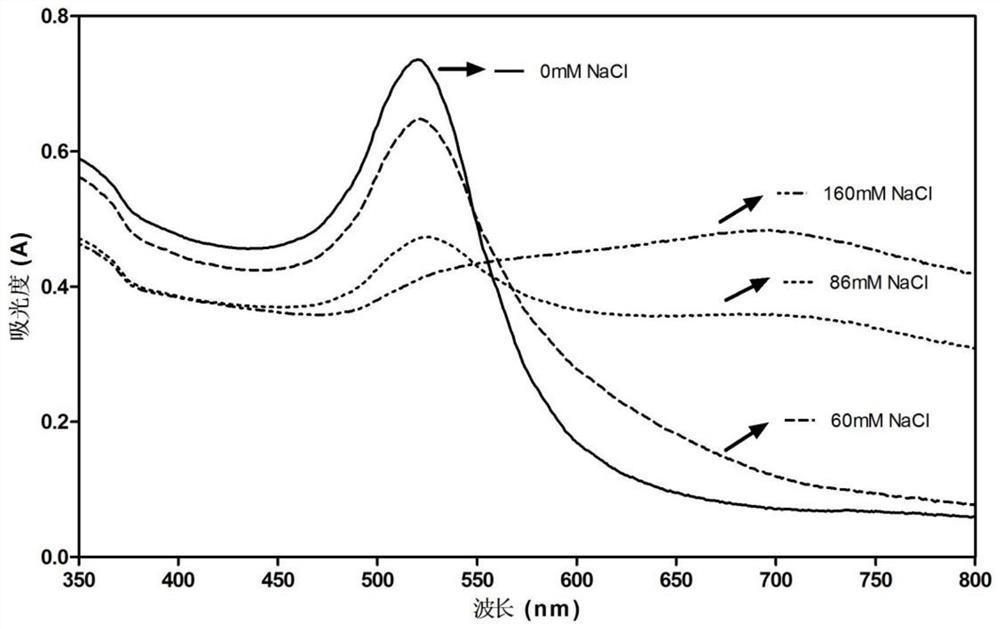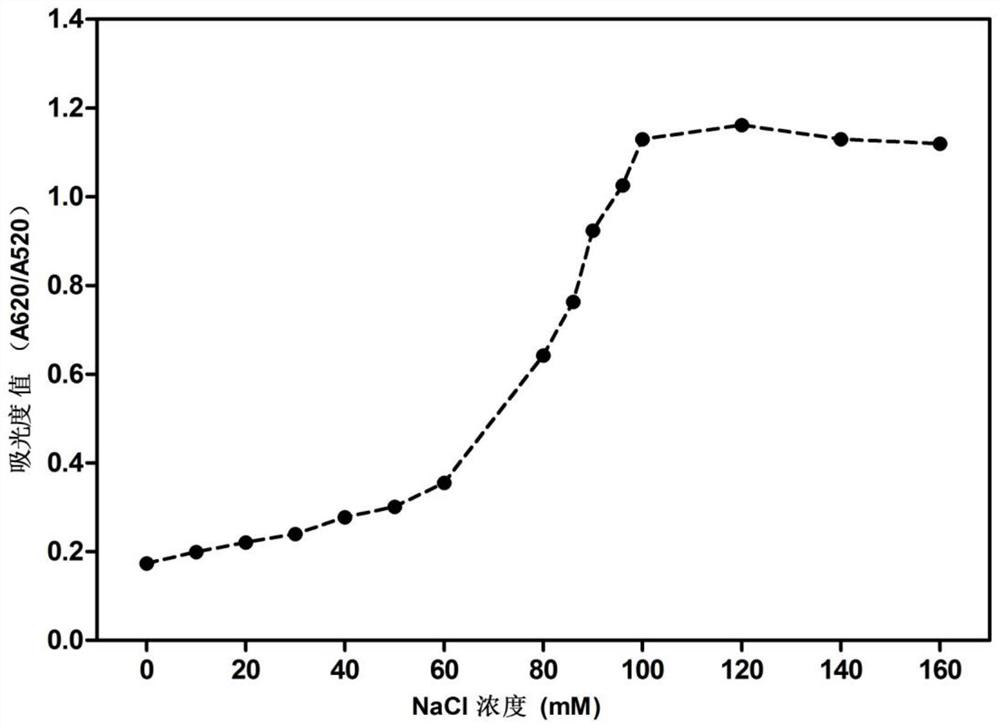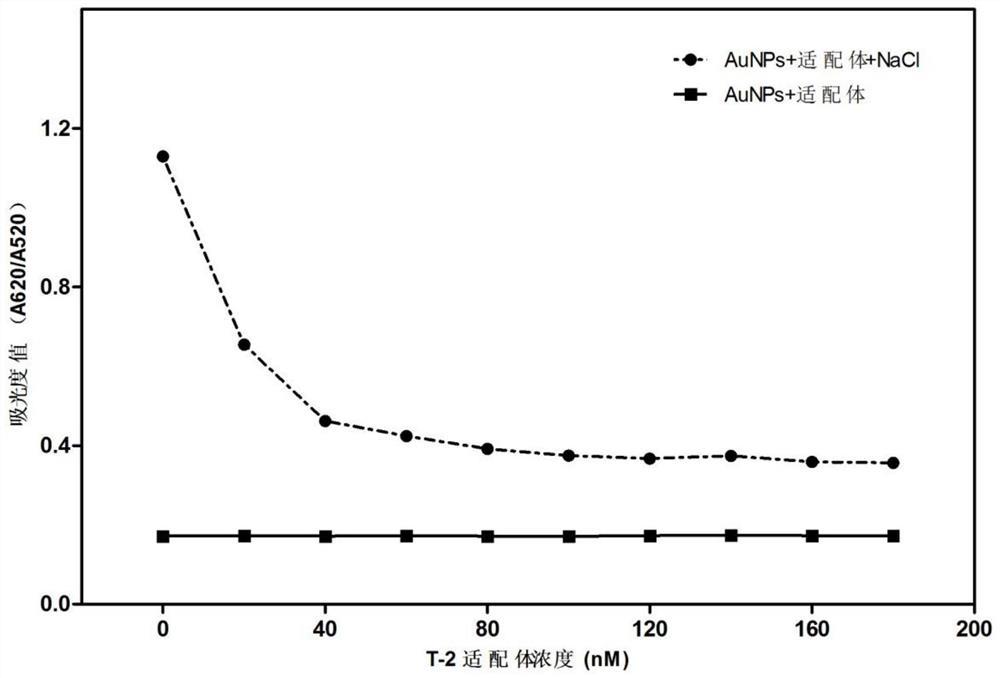Method for detecting T-2 toxin
A detection method, T-2 technology, applied in the direction of measuring devices, biological tests, material inspection products, etc., can solve problems such as complex procedures, inability to meet the requirements of T-2 real-time and rapid detection, time-consuming and labor-intensive, etc., to achieve high selection sexual effect
- Summary
- Abstract
- Description
- Claims
- Application Information
AI Technical Summary
Problems solved by technology
Method used
Image
Examples
Embodiment 1
[0034] (1) Take T-2 standard solutions of different known concentrations as samples and perform the following operations to obtain corresponding standard reaction solutions: In a 1.5mL centrifuge tube, add 50μL, 1μM single-stranded DNA aptamer and 50μL sample Add 157 μL of 10 mM, pH 7.0 MOPS buffer, shake and mix, incubate at room temperature for 2 h, then add 200 μL of 10 nM AuNPs and incubate for 30 min, then add 43 μL of 1M NaCl solution and incubate for 10 min to obtain 500 μL of standard reaction solution;
[0035] (2) Each standard reaction solution is transferred to a 96-well plate, and the A620 / A520 standard value corresponding to each concentration T-2 standard solution is measured, and the curve of absorbance linear change drawn according to each A620 / A520 standard value, in this curve, In the concentration range of 0.21435~10717.5nM, the concentration of T-2 standard solution has a linear relationship with the value of A620 / A520, and the linear equation is obtained: ...
Embodiment 2
[0039] (1) Take T-2 standard solutions of different known concentrations as samples and perform the following operations to obtain corresponding standard reaction solutions: In a 1.5mL centrifuge tube, add 40μL, 1μM single-stranded DNA aptamer and 40μL sample Add 180 μL of 10 mM, pH 7.0 MOPS buffer, shake and mix, incubate at room temperature for 1 hour, then add 200 μL of 10 nM AuNPs and incubate for 20 minutes, then add 40 μL of 1M NaCl solution and incubate for 5 minutes to obtain 500 μL of standard reaction solution;
[0040] (2) Each standard reaction solution is transferred to a 96-well plate, and the A620 / A520 standard value corresponding to each concentration T-2 standard solution is measured, and the curve of absorbance linear change drawn according to each A620 / A520 standard value, in this curve, In the concentration range of 0.21435~10717.5nM, the concentration of T-2 standard solution has a linear relationship with the A620 / A520 value, and the linear equation is obt...
Embodiment 3
[0044] (1) Use T-2 standard solutions of different known concentrations as samples and perform the following operations to obtain corresponding standard reaction solutions: In a 1.5mL centrifuge tube, add 60μL, 1μM single-stranded DNA aptamer and 60μL sample Add 130 μL of 10 mM, pH 7.0 MOPS buffer, shake and mix, incubate at room temperature for 1 h, then add 200 μL of 10 nM AuNPs and incubate for 40 min, then add 50 μL of 1M NaCl solution and incubate for 20 min to obtain 500 μL of standard reaction solution;
[0045] (2) Each standard reaction solution is transferred to a 96-well plate, and the A620 / A520 standard value corresponding to each concentration T-2 standard solution is measured, and the curve of absorbance linear change drawn according to each A620 / A520 standard value, in this curve, In the concentration range of 0.21435~10717.5nM, the concentration of T-2 standard solution has a linear relationship with the A620 / A520 value, and the linear equation is obtained;
[...
PUM
| Property | Measurement | Unit |
|---|---|---|
| recovery rate | aaaaa | aaaaa |
| recovery rate | aaaaa | aaaaa |
Abstract
Description
Claims
Application Information
 Login to view more
Login to view more - R&D Engineer
- R&D Manager
- IP Professional
- Industry Leading Data Capabilities
- Powerful AI technology
- Patent DNA Extraction
Browse by: Latest US Patents, China's latest patents, Technical Efficacy Thesaurus, Application Domain, Technology Topic.
© 2024 PatSnap. All rights reserved.Legal|Privacy policy|Modern Slavery Act Transparency Statement|Sitemap



